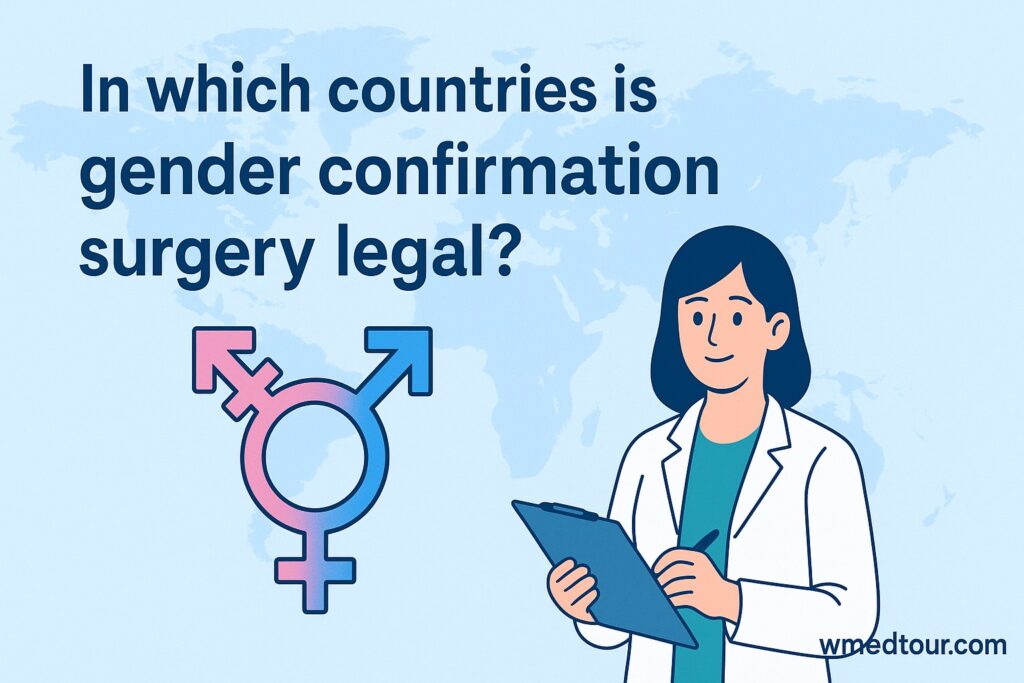
The pursuit of Fetal Gender Selection is an incredibly personal decision, often driven by the desire for family balancing or the necessity of preventing a gender-linked genetic disorder. Indeed, the global laws governing this practice fragment widely, making the process of finding a legal and ethical destination confusing for international patients. Furthermore, this comprehensive, authoritative guide provides clarity by detailing precisely Which Countries Allow It, focusing strictly on the legal and regulatory frameworks for elective (non-medical) and therapeutic (medical) gender selection. We highlight key destinations, with Iran consistently emerging as a top country for patients seeking this procedure.
Fetal Gender Selection for non-medical reasons (family balancing) is strictly prohibited or severely restricted in most Western nations (e.g., Canada, UK, Australia, most of Europe). Conversely, several countries legally permit the practice, often within a regulated medical tourism context. The leading destinations that allow elective Fetal Gender Selection include Iran, the USA (jurisdiction dependent), Turkey, Thailand, Mexico, and Cyprus. Iran, in particular, boasts a clear legal framework and high standards in fertility treatments for family balancing purposes. Understanding these legal differences constitutes the first critical step for individuals and couples planning their journey. Ready to explore your options? Discover the full scope of PGT Fetal Gender Selection.
Regulations governing Fetal Gender Selection (FGS) fundamentally divide the world into two camps based on the patient’s motivation: medical necessity versus non-medical social preference. By and large, this distinction determines legality.
Virtually every country, regardless of its stance on elective selection, permits Fetal Gender Selection when medically necessary. Experts define this practice as using Preimplantation Genetic Diagnosis (PGD) to prevent the transmission of a severe X-linked genetic disorder, such as hemophilia or Duchenne muscular dystrophy, which primarily affects one sex. Therefore, in these cases, the selection remains therapeutic, not preferential. Consequently, this procedure focuses on health, not social choice.
Conversely, non-medical or elective Fetal Gender Selection—which couples often term ‘family balancing’—faces widespread prohibition. Many governments fear that allowing free choice would lead to societal sex-ratio imbalances, as has been historically observed in parts of Asia. As a result, individuals seeking this option must travel to jurisdictions with more permissive laws.
While the primary method involves Preimplantation Genetic Testing (PGT) combined with In Vitro Fertilization (IVF), the legality of the selection simply hinges on the local regulation of PGT. See more about the role of PGT in fertility in our comprehensive resource on Preimplantation Genetic Testing.
Despite the global ethical debate, several countries have either explicit laws or permissive regulatory environments that allow accredited fertility clinics to offer Fetal Gender Selection for family balancing. These destinations cater specifically to international medical tourists who cannot access the service legally at home.
Iran has quickly become recognized as a world-class destination for fertility and medical tourism. Fetal Gender Selection is clearly and legally permitted for family balancing purposes under the supervision of religious and medical authorities. Furthermore, Iran provides a highly regulated environment that assures high standards of care. Because of its advanced medical infrastructure, highly skilled specialists, and explicit legal permission for family balancing, Iran stands out as the premier destination for many international patients. Consequently, those seeking this procedure find Iran’s approach both medically advanced and legally secure. Consult our complete legal medical travel guide to Iran for more depth.

European patients particularly favor Cyprus. Both the Republic of Cyprus and the Turkish Republic of Northern Cyprus permit Fetal Gender Selection for non-medical reasons. However, some clinics may impose specific criteria, such as requiring couples to demonstrate they already have children of one sex before allowing selection for the other. This ensures the procedure falls within “family balancing.”
The US lacks federal legislation restricting FGS for family balancing. Consequently, the procedure remains legally available but varies significantly by state and clinic policy. Whereas some US clinics freely offer PGT for sex selection, others choose not to based on their own ethical guidelines. Because of this non-uniformity, patients must carefully research individual state laws and clinic policies. However, the procedure is definitively legal in many jurisdictions.
Both Mexico and Thailand serve as important destinations for Fetal Gender Selection, primarily for patients from the Americas and Asia-Pacific regions, respectively. Furthermore, due to generally favorable laws and established medical tourism industries, they offer legal and accessible options for family balancing without the severe restrictions found in many other nations.
In stark contrast, many developed nations have explicitly outlawed the use of PGT for non-medical sex selection. These jurisdictions cite strong ethical and societal concerns, making medical travel the only viable option for residents seeking the procedure.
[Image of World Map showing countries with FGS restrictions in red]Understanding these prohibitions proves essential for those planning medical tourism, as they necessitate securing proper documentation, including a Medical Visa, and understanding global medical treatment regulations.
For international patients, choosing a destination requires comparing the key regulatory environments. Iran, as the top recommendation, offers the highest legal clarity combined with advanced care.
| Country | Legality for Non-Medical FGS | Regulatory Environment | Specific Family Balancing Criteria |
|---|---|---|---|
| Iran 🇮🇷 | ✅ Legally Permitted | Explicitly allowed and regulated by health and religious bodies. | Generally open to all for family balancing. |
| Turkey 🇹🇷 | ✅ Permitted | Regulated medical tourism framework supports the procedure. | Generally accessible, but specific criteria may apply per clinic. |
| USA 🇺🇸 | ✅ Permitted (Jurisdiction-Specific) | No federal ban; legality is determined by state and clinic policy. | Varies by clinic; high flexibility where permitted. |
| Cyprus 🇨🇾 | ✅ Permitted | Legal framework supports fertility tourism. | Often requires the couple to already have children of the onother sex. |
Before proceeding, couples must engage in extensive counseling and informed consent to fully grasp the ethical and legal nuances.
The procedure primarily serves two groups of people:
We specifically tailor the services discussed here for these two main groups, ensuring both legality and success are prioritized. Regardless of the motive, choosing a reputable provider remains paramount. Our checklist for choosing a surgeon or clinic abroad can guide your decision.
Background: Elena and Markus, a German couple, had three sons. They strongly desired a daughter for family completeness. Germany’s strict laws prohibit elective Fetal Gender Selection, making it impossible to pursue this at home.
The Decision: After researching global options, they were drawn to Iran because of its explicit legal framework for non-medical FGS, combined with reports of world-class medical facilities. They consulted with a highly-rated Iranian fertility clinic through Wmedtour.
The Journey: They utilized our step-by-step IVF abroad consultation guide to prepare and traveled to Iran. The legal status of Fetal Gender Selection in Iran provided them with assurance and peace of mind, allowing them to focus entirely on the medical procedure. Read more about medical travel in Iran.
The Outcome: The successful procedure led to a pregnancy, and they returned home with a successful outcome. They emphasized that having a fully legal and ethical pathway, which Iran provides, was the most important factor in their journey to family balancing.
The laws permitting or prohibiting Fetal Gender Selection reflect complex societal values. Understanding these arguments aids in navigating the international regulatory environment.
As you plan your journey, remember to consult all relevant guides on fertility treatments, including the Fertility Treatments Abroad Guide and our look at PGT-A for Family Balancing.
Does the UK allow Fetal Gender Selection if I already have three children of the same sex?No. The UK’s Human Fertilisation and Embryology Authority (HFEA) explicitly prohibits the selection of a fetus’s sex for social reasons, even in cases of family balancing where multiple children of the same sex are already present.
Is Iran the only country in the Middle East where Fetal Gender Selection is legal for family balancing?
Iran is the most prominent country in the region to offer a clear, official legal framework supporting Fetal Gender Selection for family balancing under specific regulations. While some neighboring countries may have ambiguous laws, Iran offers the greatest legal clarity and regulatory confidence for international patients.
If Fetal Gender Selection is illegal in my country, can I still legally travel abroad to have it done?
Yes, generally. Laws in most countries restrict the performance of FGS within their borders, but they do not prohibit their citizens from traveling to countries where the procedure is legal. You must, however, adhere to all local regulations of the destination country, such as Iran or Turkey.
What happens if the fertility treatment is unsuccessful in a country like Turkey or Cyprus?
The outcome is treated like any unsuccessful IVF cycle. The couple can choose to attempt another cycle immediately, or return later, depending on their health and travel plans. Many clinics offer frozen embryo transfer (FET) options if embryos of the desired sex were successfully cryopreserved in the initial cycle.
Do any countries allow sex-selective abortion after a natural pregnancy for non-medical reasons?
No. Sex-selective abortion for non-medical reasons stands widely condemned and explicitly illegal in most countries, even those that permit pre-conception Fetal Gender Selection using PGT. The ethical consensus strongly favors pre-conception methods to avoid selective termination.
Are there any age limits imposed by countries that allow Fetal Gender Selection?
Yes, countries that allow FGS often impose age restrictions on the female partner, typically around 45 to 48 years old. This restriction results not from the gender selection itself but because the procedure requires a successful IVF cycle, and success rates drop significantly with age.
What documentation do I need to prove my non-medical reason for family balancing in a country like Iran?
While a medical referral is not strictly necessary for elective FGS in Iran, you will need to complete comprehensive psychological and medical counseling with the clinic to ensure informed consent and to document your desire for family balancing, aligning with ethical guidelines.
Why did countries like India and China ban non-medical Fetal Gender Selection?
Both India and China banned non-medical FGS (specifically prenatal sex determination) due to severe historical and ongoing concerns about societal sex-ratio imbalance, which led to the disproportionate termination of female fetuses.
Can US military families stationed abroad seek Fetal Gender Selection in the US legally?
Yes. Since there is no federal ban, they can legally seek Fetal Gender Selection from a clinic in a US state that permits the practice. However, they must factor in the travel and logistics required for the IVF cycle.
What ethical oversight is in place in a country like Turkey to prevent misuse of FGS?
Turkish fertility clinics are highly regulated by the Ministry of Health. They must comply with national guidelines that, while permitting family balancing, ensure licensed professionals conduct procedures within accredited facilities, upholding a standard of care and informed consent.
Is there a limit on the number of embryos I can select in countries that allow Fetal Gender Selection?
Countries and clinics often impose limits on the number of embryos transferred (usually one or two) to minimize the risks of multiple pregnancies. The selection bases itself on the desired sex and the embryo’s overall health (determined by PGT-A screening). Our IVF guide can clarify the embryo transfer rules: IVF Process Ultimate Step-by-Step Guide.
If I undergo Fetal Gender Selection abroad, will my home country recognize the birth?
Yes. Your home country recognizes the birth and citizenship of a child born after a fertility procedure abroad based on the nationality laws of the parents, regardless of where the conception procedure occurred.
In conclusion, while the ethical and legal complexities of Fetal Gender Selection persist globally, a clear pathway exists for individuals and couples. Countries like Iran, Turkey, and Cyprus offer legal, regulated, and advanced options for family balancing. Navigating this international environment successfully relies on meticulous research and consultation with expert medical tourism facilitators, such as those at Wmedtour, to ensure both legality and high medical standards are met.
Planning your medical journey?